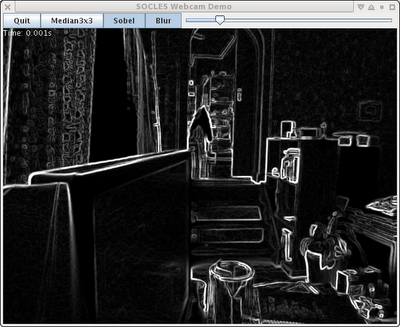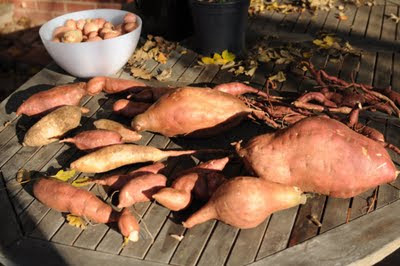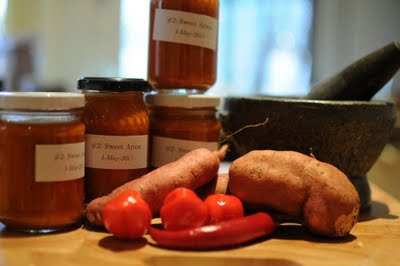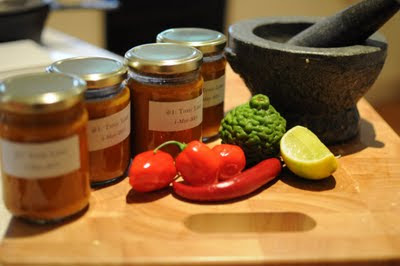About Me
Michael Zucchi
B.E. (Comp. Sys. Eng.)
also known as Zed
to his mates & enemies!
< notzed at gmail >
< fosstodon.org/@notzed >

More sort thoughts
Late last night when I should really have already headed to bed I had some more thoughts on the median filter and played a bit with a batchers sort generator.For a 9 value median, rather than do a full 9 element sort, one could just do an 8 element sort and then attempt to insert the final value into the middle. The insert which only must be valid for the centre value only takes 2 additional cas steps. But an 8 sort takes quite a few fewer steps than a 9 sort, and even then 2 are redundant for finding the median. In short, this allows a 9 element median to be calculated in only 19 cas operations rather than 22.
For larger sorts one can probably repeat the process further.
3x3 median filter, or branchless loopless sort
So while thinking of something I could add to socles to make it worth uploading I thought of implementing a median filter.
Median filters are a bit of a pain because one has to sort all of the pixel values (for a greyscale image at least) before getting the result - and sorts generally require loops and other conditional code which make things a bit inefficient when executed on a GPU.
So somehow i'm back to looking into sorts again ... the never-ending quest continues.
Fortunately, this is another case where a batchers sort or other hand-rolled sorting networks come to the rescue. And since each element is being processed independently there are no inter-thread dependencies and all the processing can be unrolled and performed on registers (if you have enough of them).
So I implemented the 9 element sorting network from Knuth Volume 3 section 5.3.4 which sorts 9 elements in 25 compare and swap steps. But since 3 of the comparisons of the 25 aren't involved in the median value I also dropped them and ended up with 22 inline comparison and swaps to find the median value. Fortunately this is a small enough problem to fit entirely into registers too.
This also works pretty well in C - an albeit-inline version - manages to perform 100M median calculations on a 9 integer array (on the same array which is copied over) in 1.26s on my workstation, using the glibc qsort() to do the same task takes 17s. (I didn't verify that the inline version was transferring data to/from memory as it should in the micro-benchmark, but that does sound about right all things considered).
So, given unsorted values s0-s8, and an operator cas(a, b) (compare and swap) which results in a < b, the median can be calculated using the following 22 steps:
cas(s1, s2);
cas(s4, s5);
cas(s7, s8);
cas(s0, s1);
cas(s3, s4);
cas(s6, s7);
cas(s1, s2);
cas(s4, s5);
cas(s7, s8);
cas(s3, s6);
cas(s4, s7);
cas(s5, s8);
cas(s0, s3);
cas(s1, s4);
cas(s2, s5);
cas(s3, s6);
cas(s4, s7);
cas(s1, s3);
cas(s2, s6);
cas(s2, s3);
cas(s4, s6);
cas(s3, s4);
s4 now contains the median value. cas can be implemented using 1 compare and 2 selects.
But perhaps the nicest thing is the code is directly vectorisable.
Some timings using a 4 channel 32-bit input image 640x480 and producing a 4 channel 32-bit output image: For 1 element it takes 84uS, for 3 elements 175uS and 4 elements 238uS. This is on a NVidia 480GTX.
The current implementation: median.cl.
socles
I finally started a new project to store some of the simpler OpenCL stuff i've been working on.I've called it socles - a socle is another word for plynth - the base of a column.

It's a really basic set of operations at the moment, but I hope they are decent implementations thereof at least.
Convolved out
Bit of a dry post coming up, but when you consider I blew my Sunday on this it might make sense. Curiosity got the better of me today and I spent most of it playing with convolutions with OpenCL on a GPU - I had a pretty fast implementation but wanted to compare it with some other ideas I had.
As it turned out, the implementation I had was the fastest after-all, although I tweaked it a tiny bit during the process.
For kernels at 3x3 (or 7x7 for 4-channel UBYTE images), a simple 2d implementation is very slightly faster than a more complex algorithm.
For non-separable convolution, a complex implementation which uses a rolling buffer is over 3x faster than a naive implementation, at least up to sizes of 31x31.
For separable convolution, my complex implementation is up to 2.5x faster than a naive implementation.
My separable convolution implementation reads 16x16 blocks of image into local memory and then each thread generates all results from the local memory in one pass - e.g. for up to 7x7 convolution it reads 2x16x16 blocks, for up to 15x15 convolution it reads 3x16x16 blocks, and so on i.e. you need the 16x16 data plus 'kernel radius' pixels each size. It uses transpose for the Y convolution case during load and saving of the data but the processing is identical. It also uses the trick of offsetting the odd rows of the data so they avoid local memory contention when they might otherwise - e.g. when the number of bocks being read is even.
FWIW for 640x480 image on a GTX 480 A single channel FLOAT 31x31 separable convolution is about 190uS, or 470uS for naive version. For UBYTE 177uS vs 470uS. For a 4 channel image the timings are 413uS, 916uS, 389uS, and 465uS respectively. So larger (byte size) images gain more - presumably from the reduction in memory reads and lower cache loading.
Actually - yesterday I started working on a JOCL based image processing library that I intend to drop on google code at some point - and this investigation was part of that. More should be forthcoming on that soon although right now I just don't have enough put together to be much use.
Luser error
So it turns out the main problem with the performance issues in my last post wasn't the cache being overloaded after all ... but the compiler running out of registers to unroll a couple of nested loops I asked it to.
It turns out because of a cut and paste job I left in some test code which was limiting the register count for the compiler, and the register spillage was a bit of a disaster and causing the order of magnitude drop. With this fixed things look a lot more promising, although at ~4ms it is still a little slower than I would like and I can't see much being able to be done to improve it.
It's a bit weird that an unconstrained compile for a specific device would choose to use all registers it needs for the code-unrolling, ignoring the device specifics, but I guess this is some particular of the nvidia opencl implementation.
There is still some problems with the texture cache being hit too hard anyway - the integral image has to be stored using the UINT32 data type, and it needs at least 8 lookups per feature tested which is a pretty heavy load to start with. With the other feature tester I could just use 8 bit images which fits better into the cache it seems (contrary to what i'd believed until this point).
Investigations ongoing ...
Cache only works when there's enough
Update: Seems I was (mostly) wrong - see the follow-up post.
I've been playing with object classifiers in OpenCL - I have one that works, not terribly well but relatively quickly. It's a random tree classifier and just uses pixel intensity comparisons for feature tests. Although I can get some results out of it they just weren't reliable enough.
So I decided to use 2-bit-binary patterns instead, a haar-like feature measure which uses an integral image to accelerate the intensity comparisons (maybe more on the integral image creation another time, that was a bit of a journey in OpenCL as well). Unfortunately the simple modifications required to change the feature detector suddenly blew out the computation time - from under 1ms to over 20ms, making it far too slow. This even though it only requires twice the memory accesses for the same number of tests.
After much experimentation I found the cause - the texture cache was being exhausted, dramatically reducing the apparent memory throughput. I discovered that a single-tree, 3-feature tester is about the limit of the texture cache. That will execute in 150uS. 4-features take 250uS, and if I change the 4-feature system to 2 trees, or 8 features - just twice the amount of work - it blows out to 1500uS.
Well, at least that gives me options for splitting the work into multiple passes and maybe i'll end up with something fast enough over-all. Otherwise I might have to find something else. As it is i'm losing confidence that it is going to be good enough anyway (maybe after running it so many times i've forgotten how poor the previous one was).
Hot Sauce #2 - Sweet Arson
As it turns out it was a rainy day and I thought the fresh habaneros either needed to be used or frozen so I made another sauce today as well.

The week previously I had excavated a patch of sweet potatoes and ended up with a reasonable haul (the largest in the photo is 2.4kg) ... and I had the idea of using the sweet potato as the base for this sauce. And this time I thought i'd try a warming mix of herbs to compliment it. I'm really quite pleased with this one - it has quite an interesting and pleasant flavour and will leave your lips burning from even quite a small amount.
Ingredients
| 450g |
Roasted sweet potato (2-3 average tubers). |
| 12 |
Cayesan Chillies, roasted. |
| 12 |
Habaneros, roasted. |
| 150ml |
Grapeseed oil. |
| 1 |
Diced onion. |
|
Dry Spices
|
| 2 tsp |
Coriander seed. |
| 1 tsp |
Cardomon seed. |
| 1 tsp |
Black peppercorns. |
| 1 tsp |
Whole allspice. |
| 2 |
Cloves. |
| 1 tsp |
Fennel seed. |
|
Liquids
|
| 2 cups |
Malt vinegar. |
| 1 1/2 cup |
Water. |
| 1 tsp |
Citric Acid. |
| 1 tsp |
Salt |
| 1 tsp |
MSG |
Method
Place the sweet potato whole and un-peeled into a roasting tray and roast until done - about an hour. Place the chillies on another tray and roast until they start to collapse - about 20 minutes. Remove the potatoes from the oven and let them cool to a suitable temperature for handling and peel the skins off (perhaps sweating them under foil will help).
Meanwhile, place the oil and onion in a medium sized saucepan and cook slowly on low heat - so they become translucent but do not brown.
Take the dry seeds and toast lightly in a dry pan for a few minutes. Use a medium heat and constantly move them so they do not burn. Transfer the seeds to a mortar and pestle and pound to a fine dust.
Add the dry spices to the onions and cook for a couple of minutes.
Add the roasted chillies and sweet potato and mash them together.
Add all of the liquid before it starts to burn, together with the remaining ingredients and simmer for at least 30 minutes on a very low heat.
Use a stick blender to thoroughly blend everything into as fine a liquid as it's capable of (i'm using a Tiffany hand-me-down and it struggles but works).
Bottle.
Results
This tastes really nice so far. Very subtle, slightly sweet and nutty flavour with a lip-burning kick to follow up which seems to multiply with every subsequent taste.
I didn't think it was going to end up hot enough after adding the liquid I needed to make it thin enough, so I threw in another half-dozen chopped habaneros when it was nearly done, cooked them for a while and re-blended. This might be the last hot sauce I make for a while too, so I wanted to make sure it counted!
I'd probably rate this 7.5 out of 10 for heat.
 Update So 6 months on, this is definitely my favourite sauce. I think it could use a bit more heat but the flavour goes with lots of things - i sometimes use it instead of butter on sandwiches, for dipping chips (it gets hot!), or to add a pleasant kick to pasta, steak, or a snag. Please comment if you give it a go ...
Update So 6 months on, this is definitely my favourite sauce. I think it could use a bit more heat but the flavour goes with lots of things - i sometimes use it instead of butter on sandwiches, for dipping chips (it gets hot!), or to add a pleasant kick to pasta, steak, or a snag. Please comment if you give it a go ...
Hot Sauce #1 - Toxic Lime
Back with another sauce - this time I thought i'd try something of a Thai theme: lime, kaffier lime, lemongrass, and fresh coriander. I just grabbed a few things from the garden and the pantry that seemed to match and came up with my second sauce, Sauce #1 - Toxic Lime.

Ingredients
| 350g |
Apples, cored. |
| 60g |
Fresh coriander, including root and stem. |
| 70g |
Fresh lemongrass. |
| 40g |
Fresh ginger. |
| 12g |
Fresh lemon basil leaves. |
| 2 |
Kaffir lime leaf. |
| 1 |
Kaffir lime zest. |
| 2 |
Limes, juice and zest. |
| 200g |
Cayesan chillies (large fleshy chillies) |
| 100g |
Habaneros (about 15) |
| 1/2 cup |
Malt vinegar. |
| 30g |
Palm sugar. |
| 1/2 cup |
Cane Sugar. |
| 1 cup |
Water. |
| 1 tsp |
Citric Acid. |
| 2 tbl |
Mushroom soy sauce (Happy Boy Brand) |
| 100ml |
Olive oil. |
Method
Cut the ginger, lemongrass and lime leaf into fine slices and then put into a food processor and process until finely chopped. Add all of the other fresh ingredients (everything until and including the chillies) and blend thoroughly into a fine paste.
Place into a medium sized saucepan on a low heat and add the liquids and bring to a slow simmer.
Stir in the sugar and simmer everything slowly 'until done' - 30+ minutes.
Use a stick blender to liquefy everything together as much as possible.
Bottle.
Results
This has a slightly strange flavour - despite lime and chilli seeming a good match I've never really found something where it truly 'worked'. Perhaps the kaffier lime zest is a little overpowering, as is the coriander. I will have to leave it for a bit and try it with some suitable food (might go well with pork?).
It definitely has a lime flavour to it though, which is what I was trying to achieve so at this point i'd call it a success. And it smells wonderful. It's probably about a 7 out of 10 for heat as with the previous recipe.
Copyright (C) 2019 Michael Zucchi, All Rights Reserved.
Powered by gcc & me!




